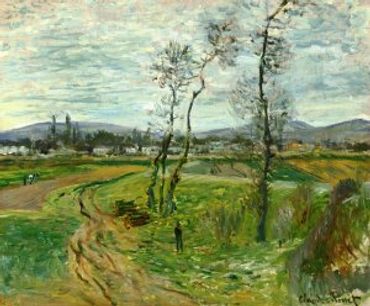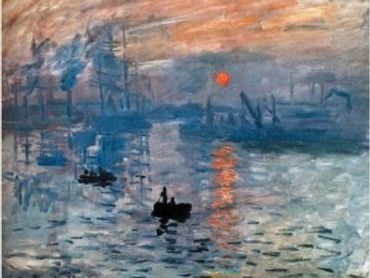Art Movement - Impressionism
Impressionism (late 19th century)
– Focused on capturing light and everyday scenes; artists include Claude Monet and Edgar Degas.
The Impressionism Art Movement
Impressionism was an influential 19th-century art movement that originated in France and marked a dramatic shift in the way artists approached painting. Emerging in the 1870s, Impressionist artists broke away from the formal, highly detailed styles favored by academic institutions. Instead, they focused on capturing fleeting moments, light, and atmosphere, often painting scenes from everyday life. Using loose brushstrokes, lighter color palettes, and open compositions, Impressionists sought to depict the world as it appeared in a particular instant, rather than as a carefully structured, idealized image. Their works often portrayed landscapes, urban scenes, and casual social interactions, emphasizing the play of natural light and its effects on surfaces.
Artists like Claude Monet, Pierre-Auguste Renoir, Edgar Degas, and Camille Pissarro were central figures in the movement. Monet’s series paintings, such as those of water lilies or the Rouen Cathedral, demonstrated how the same subject could look dramatically different depending on the time of day and weather conditions. Though Impressionism was initially met with criticism and resistance from the art establishment, it eventually gained widespread recognition and fundamentally changed the course of modern art. It paved the way for later movements like Post-Impressionism and Modernism, and it continues to influence artists around the world today.
Claude Monet
Claude Monet (1840–1926)
He was a French painter and one of the founding figures of the Impressionist movement, a term that itself was derived from his 1872 painting Impression, Sunrise (Impression, Soleil Levant). Monet is best known for his focus on capturing the effects of light and atmosphere in natural settings, often painting the same scene at different times of day or in varying weather conditions. He used quick, visible brushstrokes and a bright color palette to portray his subjects with a sense of immediacy and movement, a radical departure from the detailed realism of earlier art styles.
Throughout his career, Monet created some of the most iconic and celebrated works in Western art history. His Water Lilies series, painted in the gardens of his home in Giverny, represents the pinnacle of his exploration of reflection, light, and abstraction. Other notable series include his paintings of haystacks, poplar trees, and the Rouen Cathedral, all demonstrating his deep interest in the changing qualities of light and perception. Monet's innovative techniques and dedication to painting en plein air (outdoors) helped redefine modern painting and left a lasting legacy that continues to inspire artists and audiences around the world.







Pierre-Auguste Renoir
Pierre-Auguste Renoir (1841–1919)
He was a prominent French artist and a leading figure in the Impressionist movement. Known for his warm, vibrant palette and focus on human beauty and social scenes, Renoir brought a sense of joy and sensuality to his work. Unlike some of his Impressionist peers who focused primarily on landscapes, Renoir often painted people—especially women and children—in lively, everyday settings such as cafes, parks, and gardens. His loose brushwork and rich, luminous colors captured the fleeting effects of light while also conveying a sense of softness and intimacy.
One of Renoir’s most famous works, Luncheon of the Boating Party (1881), exemplifies his ability to depict relaxed social interactions with charm and elegance. Over time, Renoir's style evolved; in his later years, he moved away from the loose, fluid strokes of early Impressionism toward a more structured and classical approach, focusing on the human form with greater solidity and definition. Despite struggling with rheumatoid arthritis later in life, he continued to paint with great passion. Renoir's dedication to portraying life’s pleasures and his emphasis on warmth and beauty have made him one of the most beloved painters of his time.

Edgar Degas
Edgar Degas (1834–1917)
He was a French artist best known for his innovative depictions of movement, especially through his paintings, drawings, and sculptures of dancers. Though often associated with the Impressionist movement, Degas preferred to call himself a "realist" or "independent," as his approach differed from many of his contemporaries. While Impressionists typically painted outdoors (en plein air) and focused on natural light, Degas was more interested in artificial light, indoor settings, and the composition of figures in motion. His art often captured behind-the-scenes glimpses of modern urban life, particularly the private, unguarded moments of ballet dancers, laundresses, and women at their toilette.
Degas combined classical training with a modern sensibility, influenced by both the Old Masters and contemporary photography and Japanese prints. He was a master of line and often worked in pastels, which allowed him to layer vivid colors and create a sense of dynamic motion. One of his most iconic works, The Ballet Class (1874), shows his fascination with the discipline, grace, and fatigue of dancers in rehearsal. In later life, Degas also produced a number of expressive sculptures, including Little Dancer of Fourteen Years. His unique perspective, focus on the human body in motion, and experimental techniques made him a central and distinctive figure in 19th-century art.

This website uses cookies.
We use cookies to analyze website traffic and optimize your website experience. By accepting our use of cookies, your data will be aggregated with all other user data.


